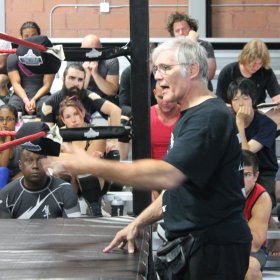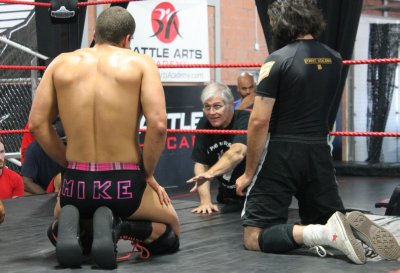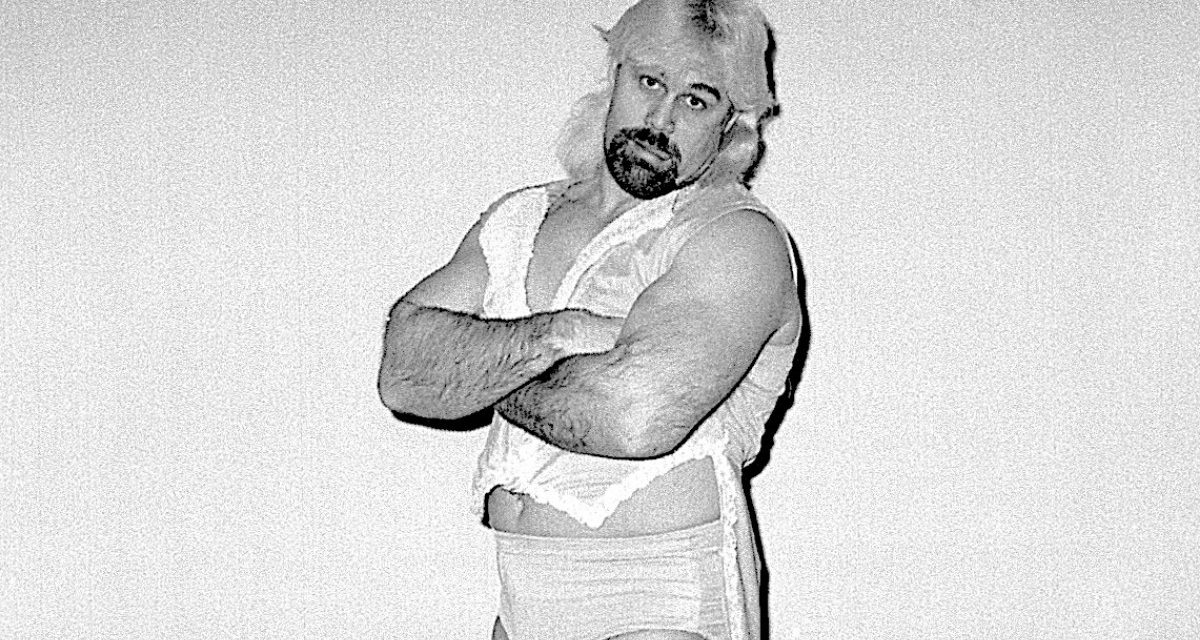MISSISSAUGA, Ont. — By his own count, “Hustler” Rip Rogers has had a hand in training 61 different wrestlers that have made it to the rosters of WWE or TNA. Few others can match that number, or the sheer fame of names like Cena, Lesnar, Orton, Batista. So when he came to the Toronto area recently for a two-day seminar, it was an opportunity to learn from a master — and a character.
Right from the start of the session at the Battle Arts Academy in Mississauga, Rogers warned the students that he was not for the faint of heart, that every second word (or more) would be a cuss word, and that his intention was to light a fire inside of you through the insults that he spewed with venomous ease.

Rip Rogers makes a point during his seminar at the Battle Arts Academy in Mississauga, Ontario. Photos by Greg Oliver
Wearing a T-shirt that said “Respect is earned not given” Rogers, who went in for hip surgery on Monday, shared all kinds of wisdom about a life in wrestling.
And what a life.
“Life lessons, right here,” he said, reminding everyone that “life ain’t fair.”
A native of Seymour, Indiana, Mark Sciarra wanted to be a wrestler from an early age, but also loved bodybuilding and honing his body. After stints in football and teaching, he debuted in 1978, helped along by “Handsome” Jimmy Valiant, and never looked back.
What followed was a career that just about took him everywhere, as did the seminar itself, as the stories rolled from territory to territory in North America, to overseas to Japan, South Africa, Germany, England, Austria, and Puerto Rico. He tossed out names that he knew and worked with — Pat Patterson, John Mellancamp (they are from the same town), Jim Barnett, Buddy Rose, Eugene, Ric Flair, Randy Savage, Jim Crockett, Ole Anderson, Brad Armstrong, Leroy McGuirk, Terry Garvin, and so many more.
For the last 15 years, he has been a trainer in Ohio Valley Wrestling, in Louisville, Kentucky, and did influence many of the stars of today with his training methods and advice, though a hit-and-run accident a few years ago has limited his ability to actually get into the ring. Today, he teaches an invitation-only advanced class at OVW.
He sees himself as a pariah, someone who is good enough to teach the best, but not respected or appreciated; an instructor who’s methods are unorthodox, perhaps, but who can generate results.
“I teach an art,” he explained, but also likened himself to a drill sergeant in the army, toughening up recruits for what was to come.
That is part of the reason that Rogers was brought into Battle Arts to teach the wrestling students, said George Terzis, the general manager and a former wrestler himself (albeit briefly). “I’ve had the privilege of training in OVW with Rip, and just in the short time that I was there, the things he says, it just sticks with you. You never forget it,” said Terzis, explaining that the students would learn “what it’s going to take to reach that next level.”
The key to that next level is to be prepared and do what was asked of you, Rogers said, using a specific example. Apocalypse (Eric Thompson) is a wrestler from Calgary who came to him for training and currently is in NXT as Rick Viktor, half of the tag team known as the Ascension. Rogers said that at one point Johnny Ace, then WWE’s chief of talent, told Apoc to lose 30 pounds — which he proceeded to do; then Ace didn’t like the result. Rogers foretold that those kind of mind games are something that any aspiring wrestler would face down the road.
Rogers explained his own satisfaction out of playing a heel, but also stressed the need for unique, colourful characters. For a while, he used the “queer gimmick,” as he called it, which was great because he rarely had to break a sweat, especially compared to his much harder-working colleagues.

Attentive students listen to Professor Rogers.
A few times during the seminar, Rogers called out to Santino Marella, the man behind the Battle Arts Academy, for confirmation of his lessons — and of the example that a character can last a long time in today’s WWE without all-out wrestling night after night.
The two mantras that echoed out during the session, obviously drummed into Marella’s mind from his time in OVW, were ‘When in doubt, grab a hold’ and ‘to change momentum, move.’
“I feel there’s no better instructor in the world than Rip Rogers when it comes to that American, Memphis-style, WWE, storytelling professional wrestling style,” said Marella after the seminar. “He really embraced becoming a professional wrestling coach, and if there was a PhD in professional wrestling, he’d definitely have a PhD.”
There were more than a few times that Rogers had the crowd in the palm of his hand, spinning yarns and telling tall tales. After all, Rogers has actually shared the stage with Mick Foley on a couple of occasions at comedy events.
“Nobody’s in TNA because they want to be,” Rogers said at one point, going off on a tangent about the struggling second-tier wrestling promotion.
After a lengthy monologue, Rogers invited a few wrestlers to pair up in the ring. He gave them basic instructions and let them call the match in the ring — a far cry from the often planned-to-the-last detail bouts that are the norm on the indy scene today.
At a couple of points, he stopped the impromptu bouts to teach from ringside, but usually his thoughts waited until the end of the match. A good example: don’t make every move work, there has to be some failure, some slipping out or countering of holds or what is the point.
“You will never have a perfect match, but you’ll hope for one,” Rogers preached.
In the end, his message was simple: “Be humble. This shit is not real.”
RELATED LINKS
- October 22, 2007: “Hustler” Rip Rogers learned his lessons well
- Rip Rogers’ YouTube channel
- Twitter: @Hustler2754
Greg Oliver had talked to Rip Rogers a number of times over the years — always a trip! — but never met him in person until this seminar. Worth the wait? Channelling Rip, “&*@%^!% yeah!” Greg can be emailed at goliver845@gmail.com, and you can follow him on Twitter @gregmep.

